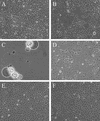Generation of novel syncytium-inducing and host range variants of ecotropic moloney murine leukemia virus in Mus spicilegus
- PMID: 12692209
- PMCID: PMC153962
- DOI: 10.1128/jvi.77.9.5065-5072.2003
Generation of novel syncytium-inducing and host range variants of ecotropic moloney murine leukemia virus in Mus spicilegus
Abstract
Mus spicilegus is an Eastern European wild mouse species that has previously been reported to harbor an unusual infectious ecotropic murine leukemia virus (MLV) and proviral envelope genes of a novel MLV subgroup. In the present study, M. spicilegus neonates were inoculated with Moloney ecotropic MLV (MoMLV). All 17 inoculated mice produced infectious ecotropic virus after 8 to 14 weeks, and two unusual phenotypes distinguished the isolates from MoMLV. First, most of the M. spicilegus isolates grew to equal titers on M. dunni and SC-1 cells, although MoMLV does not efficiently infect M. dunni cells. The deduced amino acid sequence of a representative clone differed from MoMLV by insertion of two serine residues within the VRA of SUenv. Modification of a molecular clone of MoMLV by the addition of these serines produced a virus that grows to high titer in M. dunni cells, establishing a role for these two serine residues in host range. A second unusual phenotype was found in only one of the M. spicilegus isolates, Spl574. Spl574 produces large syncytia of multinucleated giant cells in M. dunni cells, but its replication is restricted in other mouse cell lines. Sequencing and mutagenesis demonstrated that syncytium formation could be attributed to a single amino acid substitution within VRA, S82F. Thus, viruses with altered growth properties are selected during growth in M. spicilegus. The mutations associated with the host range and syncytium-inducing variants map to a key region of VRA known to govern interactions with the cell surface receptor, suggesting that the associated phenotypes may result from altered interactions with the unusual ecotropic virus mCAT1 receptor carried by M. dunni.
Figures





Similar articles
-
Evolution of different antiviral strategies in wild mouse populations exposed to different gammaretroviruses.Curr Opin Virol. 2013 Dec;3(6):657-63. doi: 10.1016/j.coviro.2013.08.001. Epub 2013 Aug 28. Curr Opin Virol. 2013. PMID: 23992668 Free PMC article. Review.
-
Novel host range and cytopathic variant of ecotropic Friend murine leukemia virus.J Virol. 2004 Nov;78(22):12189-97. doi: 10.1128/JVI.78.22.12189-12197.2004. J Virol. 2004. PMID: 15507605 Free PMC article.
-
Role of a third extracellular domain of an ecotropic receptor in Moloney murine leukemia virus infection.J Microbiol. 2006 Aug;44(4):447-52. J Microbiol. 2006. PMID: 16953181
-
Second site mutation in the virus envelope expands the host range of a cytopathic variant of Moloney murine leukemia virus.Virology. 2012 Nov 10;433(1):7-11. doi: 10.1016/j.virol.2012.06.031. Epub 2012 Jul 24. Virology. 2012. PMID: 22835818 Free PMC article.
-
Moloney murine leukemia virus temperature-sensitive mutants: a model for retrovirus-induced neurologic disorders.Curr Top Microbiol Immunol. 1990;160:29-60. doi: 10.1007/978-3-642-75267-4_3. Curr Top Microbiol Immunol. 1990. PMID: 2162285 Review. No abstract available.
Cited by
-
Evolution of different antiviral strategies in wild mouse populations exposed to different gammaretroviruses.Curr Opin Virol. 2013 Dec;3(6):657-63. doi: 10.1016/j.coviro.2013.08.001. Epub 2013 Aug 28. Curr Opin Virol. 2013. PMID: 23992668 Free PMC article. Review.
-
Novel host range and cytopathic variant of ecotropic Friend murine leukemia virus.J Virol. 2004 Nov;78(22):12189-97. doi: 10.1128/JVI.78.22.12189-12197.2004. J Virol. 2004. PMID: 15507605 Free PMC article.
-
Susceptibility of muridae cell lines to ecotropic murine leukemia virus and the cationic amino acid transporter 1 viral receptor sequences: implications for evolution of the viral receptor.Virus Genes. 2014 Jun;48(3):448-56. doi: 10.1007/s11262-014-1036-1. Epub 2014 Jan 28. Virus Genes. 2014. PMID: 24469466
-
Unique N-linked glycosylation of CasBrE Env influences its stability, processing, and viral infectivity but not its neurotoxicity.J Virol. 2013 Aug;87(15):8372-87. doi: 10.1128/JVI.00392-13. Epub 2013 May 22. J Virol. 2013. PMID: 23698308 Free PMC article.
-
Mutation of the Putative Immunosuppressive Domain of the Retroviral Envelope Glycoprotein Compromises Infectivity.J Virol. 2017 Oct 13;91(21):e01152-17. doi: 10.1128/JVI.01152-17. Print 2017 Nov 1. J Virol. 2017. PMID: 28814524 Free PMC article.
References
-
- Beck, J. A., S. Lloyd, M. Hafezparast, M. Lennon-Pierce, J. T. Eppig, M. F. W. Festing, and E. M. C. Fisher. 2000. Genealogies of mouse inbred strains. Nat. Genet. 24:23-25. - PubMed
MeSH terms
Substances
LinkOut - more resources
Full Text Sources
Miscellaneous

